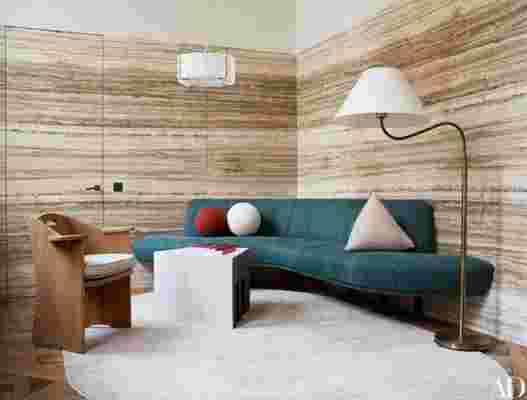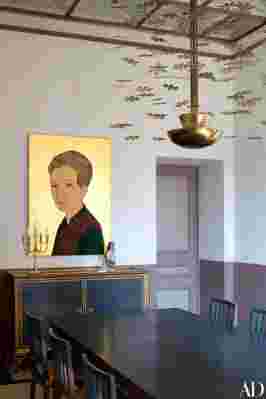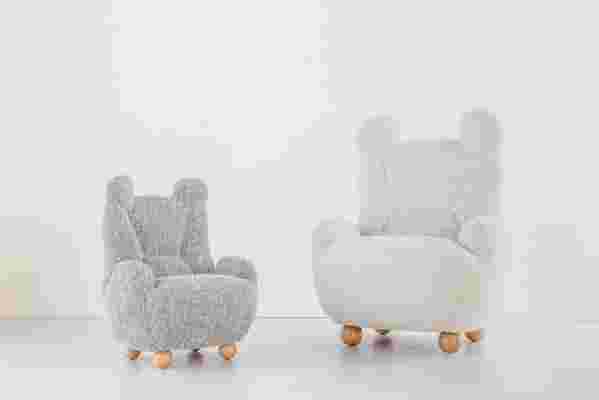Pierre Yovanovitch apologizes as he hurries into the small sitting room where I’ve been asked to wait. The interior designer recently moved his firm into this grand 18th-century hôtel particulier in Paris’s Sentier neighborhood, and the floors are still cluttered with cardboard and bubble wrap, not to mention a Georg Baselitz painting or two waiting to be hung.
Meanwhile, Yovanovitch is looking to open offices in the U.S., where an increasing number of his residential clients live. (“Americans give you a kind of fuel the French don’t,” he notes. “They say, ‘Whoa, my house is going to be the best house in the world’—even if it’s not true.”) The future New York offices will also serve as a showroom for his own furniture, like the plump Ours chair. (Once I catch the name, French for “bear,” I make out two fuzzy ears on the model sitting in the next room.) Yovanovitch plans to launch his collection in September to coincide with a design exhibition he is curating at New York’s R & Co. gallery.
Yovanovitch is a suave guy, but right now even he appears slightly frazzled by all the projects he’s juggling. “I’m very ambitious,” the talent says. That’s putting it mildly when you’ve modeled your career on that of Jean Royère, the great midcentury French designer who opened branches in the Middle East and Latin America before spending his final years in the U.S. “I’m working like a donkey,” he says. “This is not a serene life.”
You wouldn’t know it by the surroundings. Yovanovitch’s understated aesthetic makes the room feel calm: Slabs of soothing, almond-color travertine—a material he loves—cover the lower part of the walls; oak chairs by Axel Einar Hjorth, a little-known Swedish designer from the 1930s, lend a rustic note. Yovanovitch reveres him as a kind of Viking precursor to Donald Judd in the purity of his lines. The gestures here are not showy but very refined and precise, which is a Yovanovitch hallmark. (He’s always been a detail freak. Before turning to interiors, Yovanovitch oversaw Pierre Cardin’s licensing business in Belgium, and he just couldn’t stop himself from tweaking the look of the belts and ties: “They were ugly, ugly, ugly!” Eventually, he moved to Paris and was given charge of Cardin’s menswear collections.)
“I didn’t want anything over the top. This is the spirit of French design,” he says. “Very chic but restrained, minimal in its way but still warm.”



Yovanovitch is particularly good at shaping space. “He’s got an amazing sense of volume,” says Cédric Morisset of Carpenters Workshop Gallery, which collaborates frequently with Yovanovitch. Morisset remembers one cramped Paris apartment with oppressively low ceilings. After Yovanovitch’s intervention, the whole place felt airier and grander, almost as if he had altered its dimensions. “He couldn’t have raised the ceilings,” Morisset says, “but I can’t figure out how he did it.”
Perhaps this mastery of space is also what makes Yovanovitch so deft at displaying the contemporary art that he and many of his clients collect. He has designed galleries for Kamel Mennour in Paris and London as well as exhibition spaces at the Patinoire Royale contemporary art museum in Brussels. Lately he’s gone further, commissioning artists to create work on-site for several residential projects. Through Kamel Mennour, he got Japanese artist Tadashi Kawamata to fashion a giant wood bird’s nest for the bedroom of a house in Paris. “Hallucinant!” says a delighted Yovanovitch. (He now has collaborations under way with Ugo Rondinone, Daniel Buren, and James Turrell.)
For the full story, subscribe now and get the digital edition immediately.